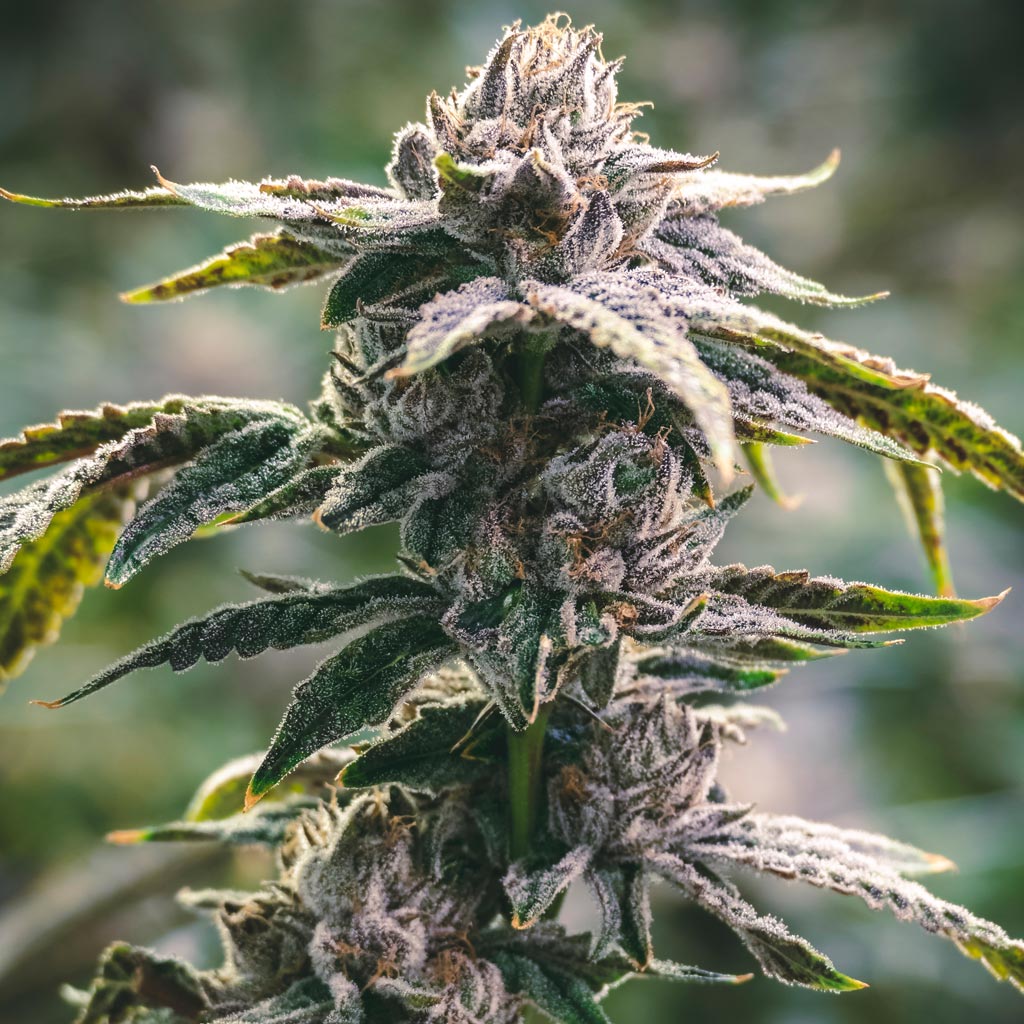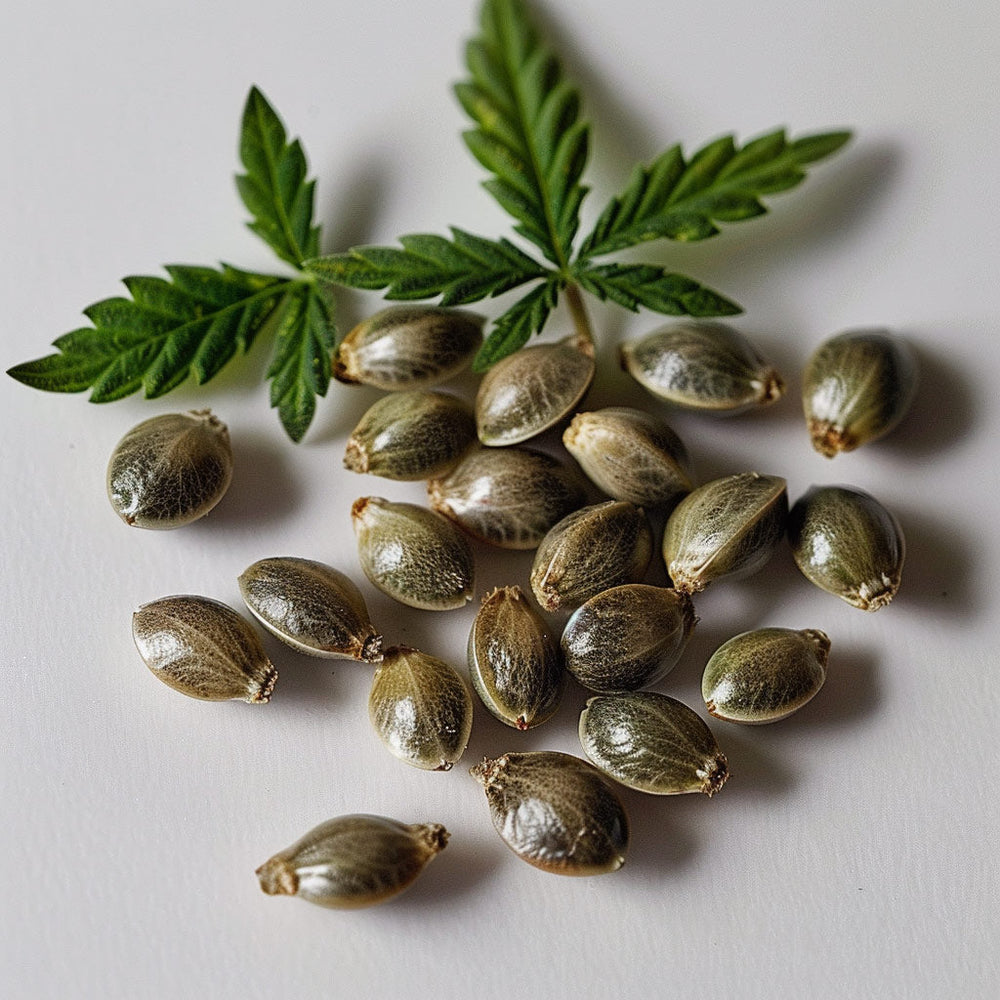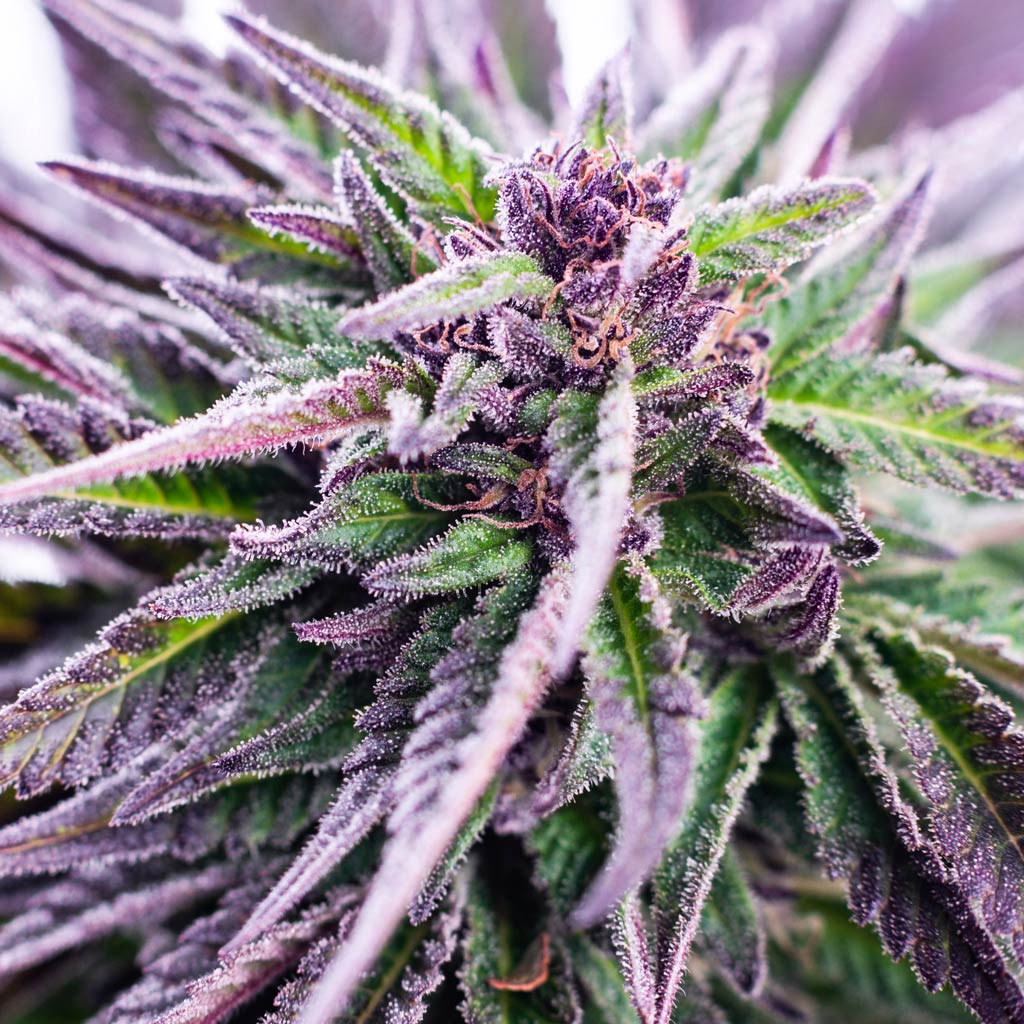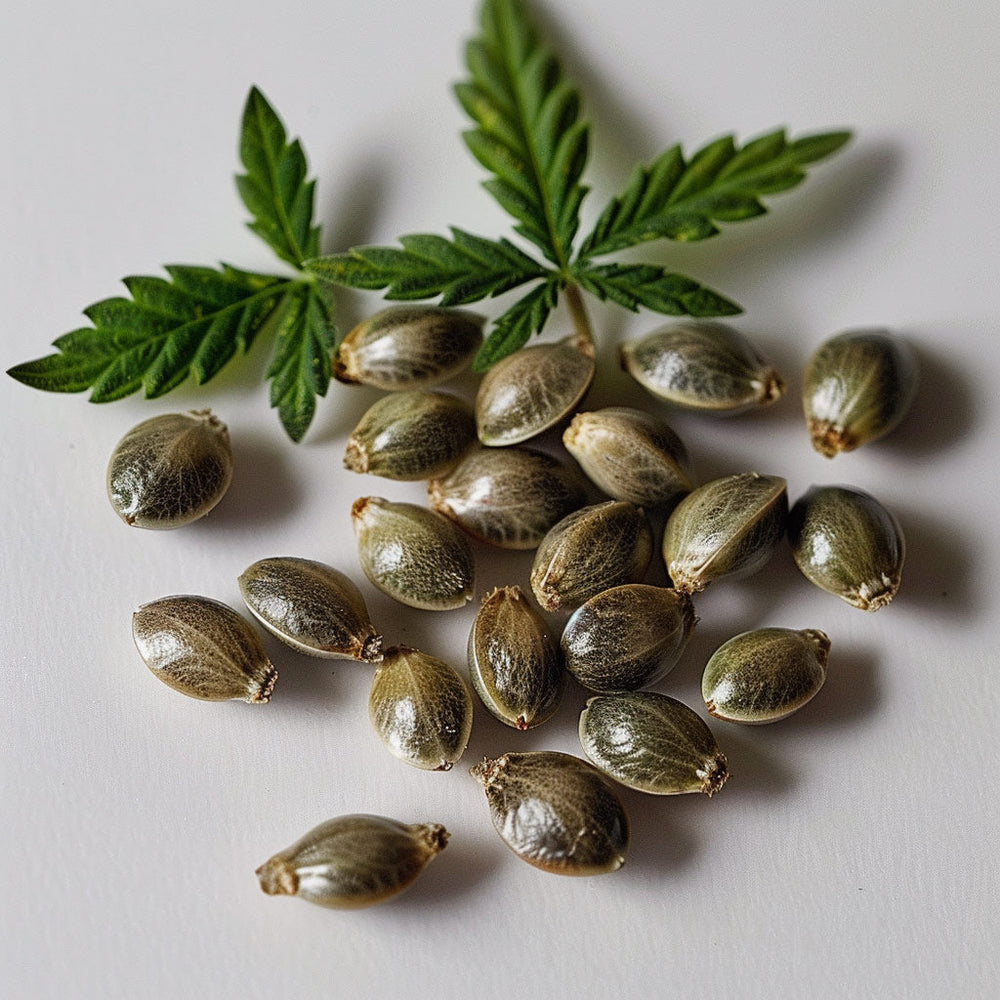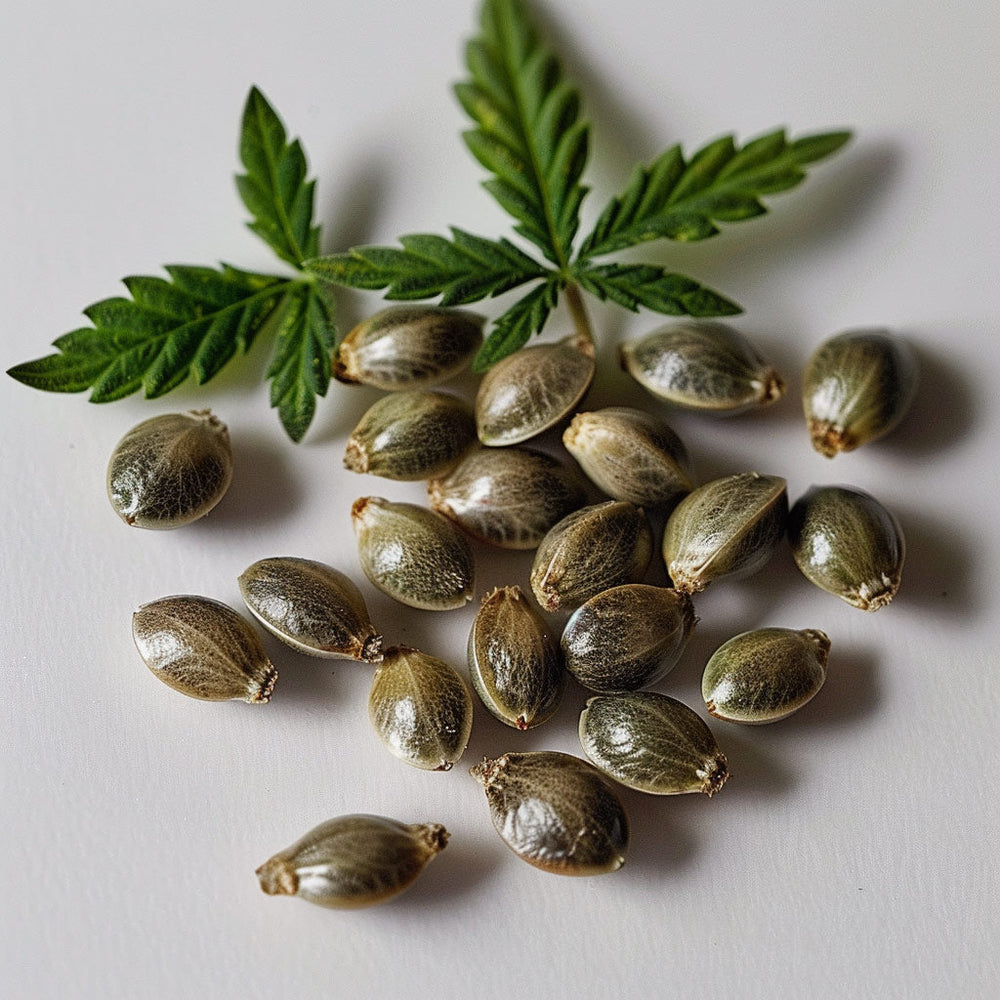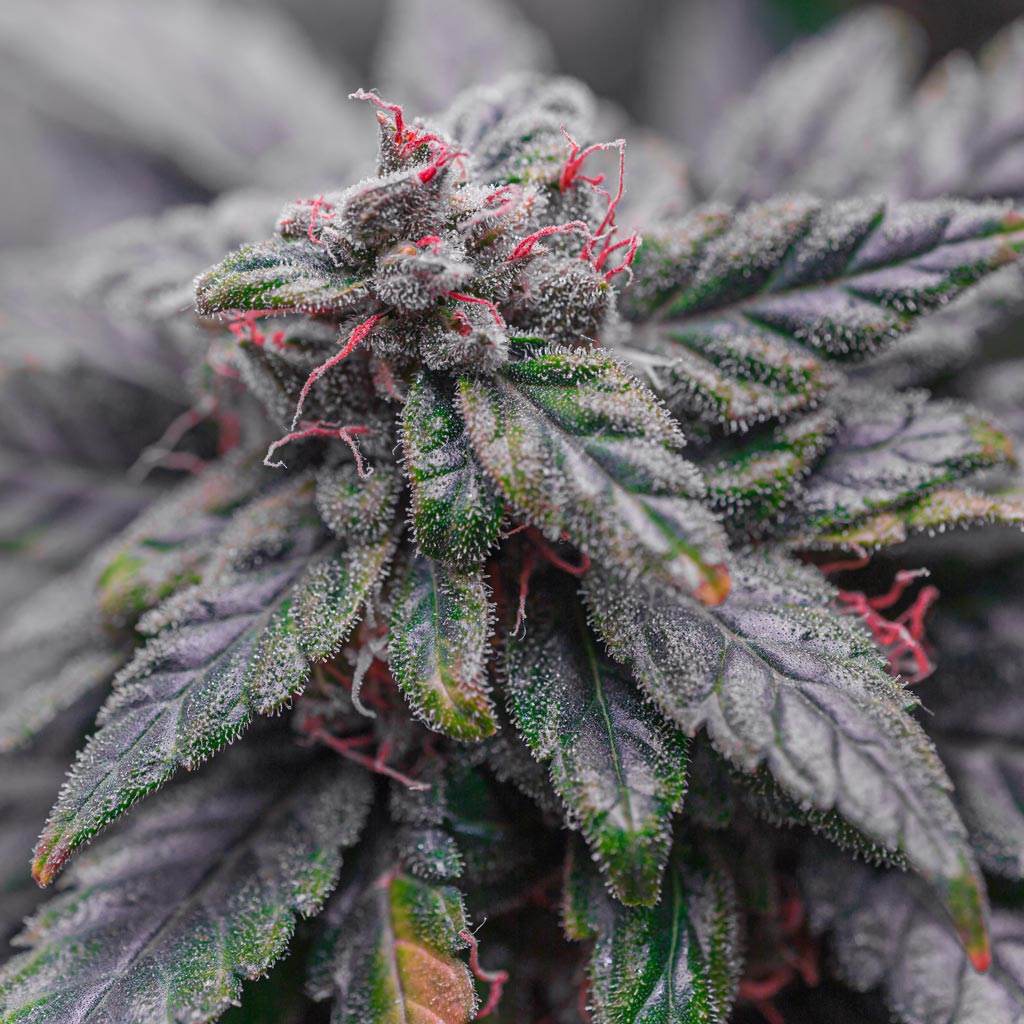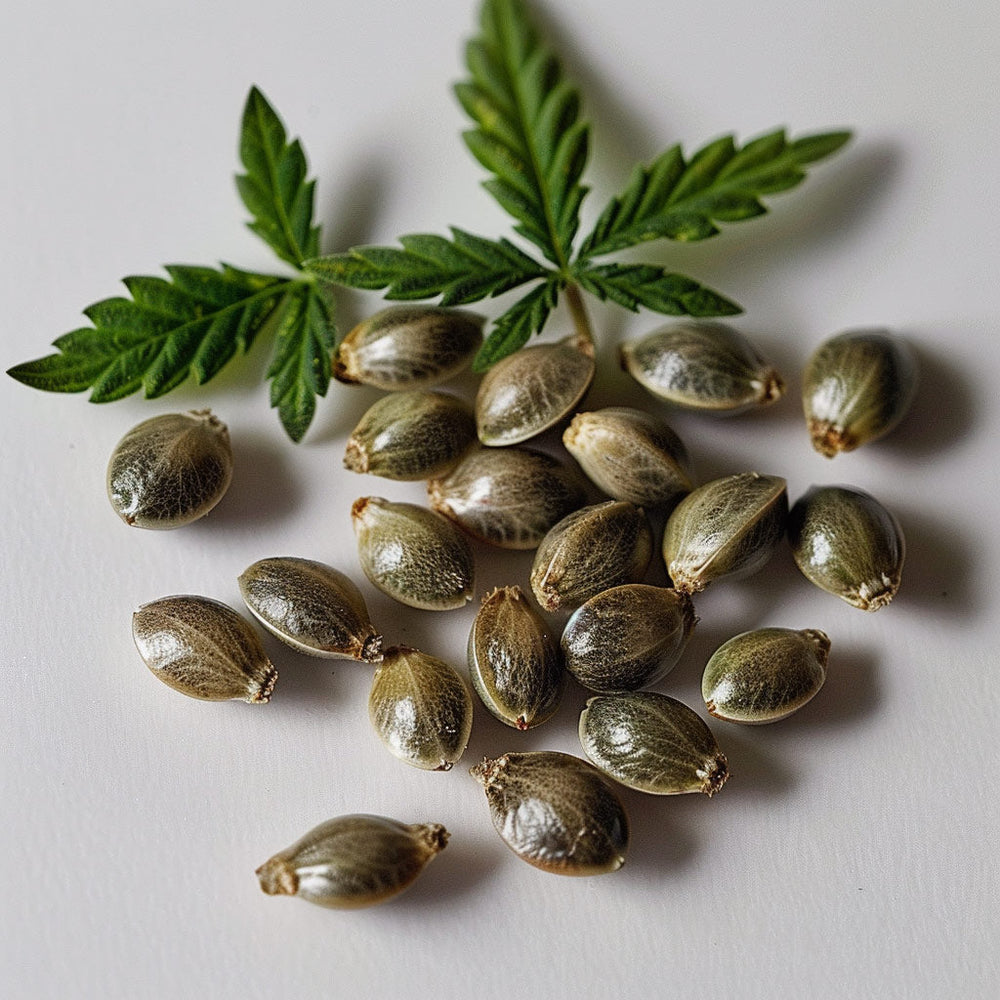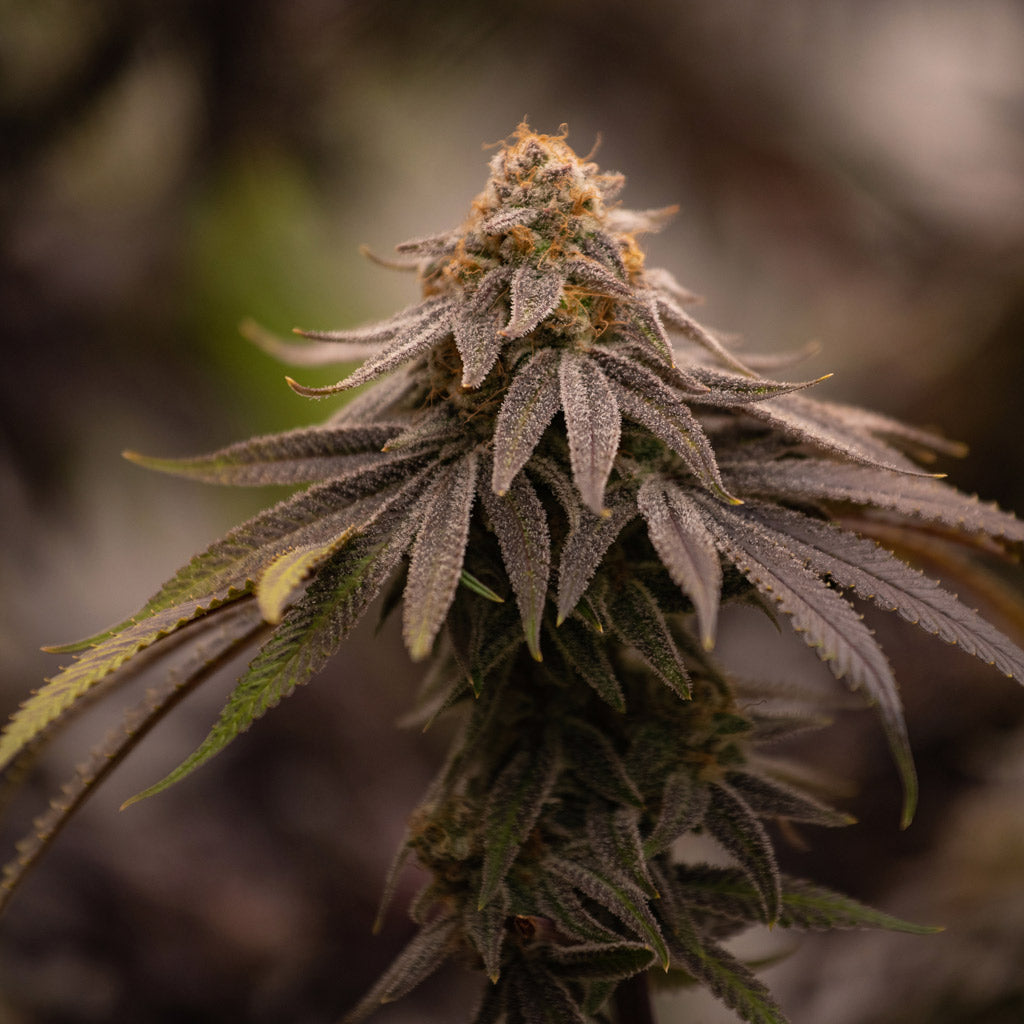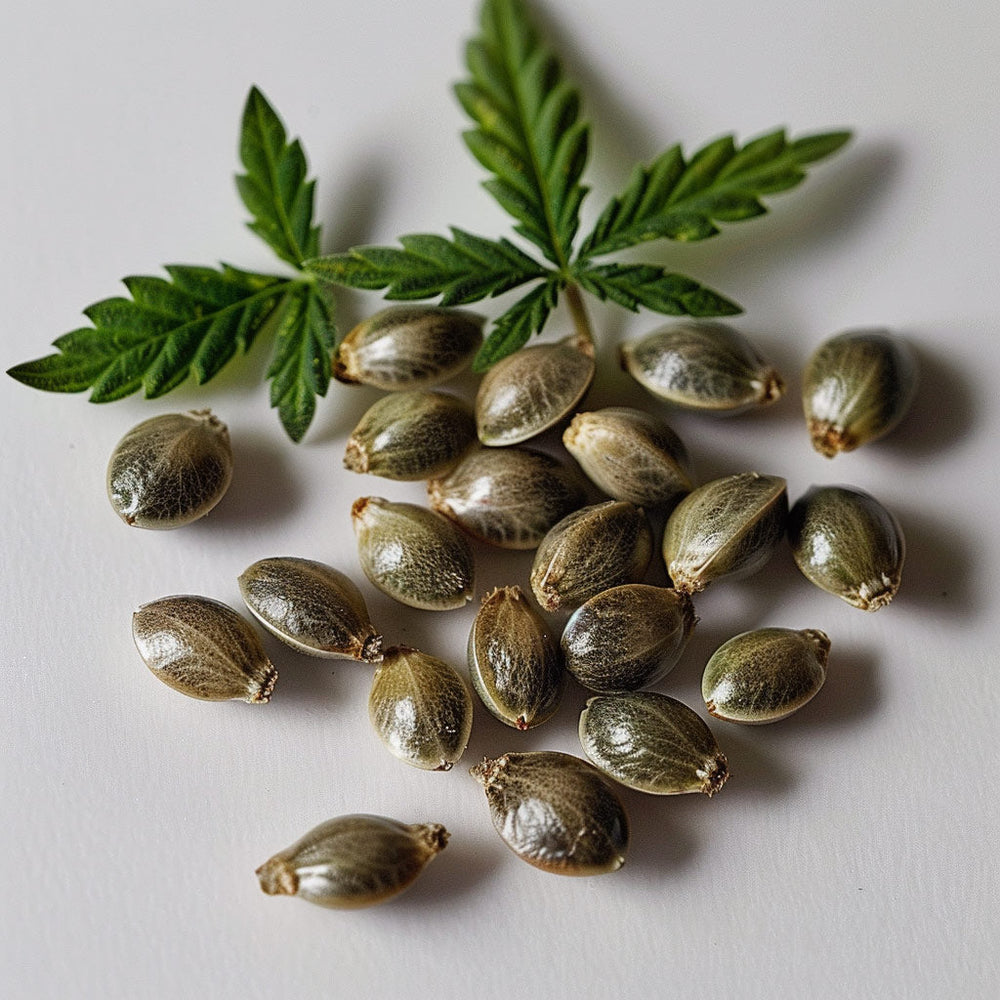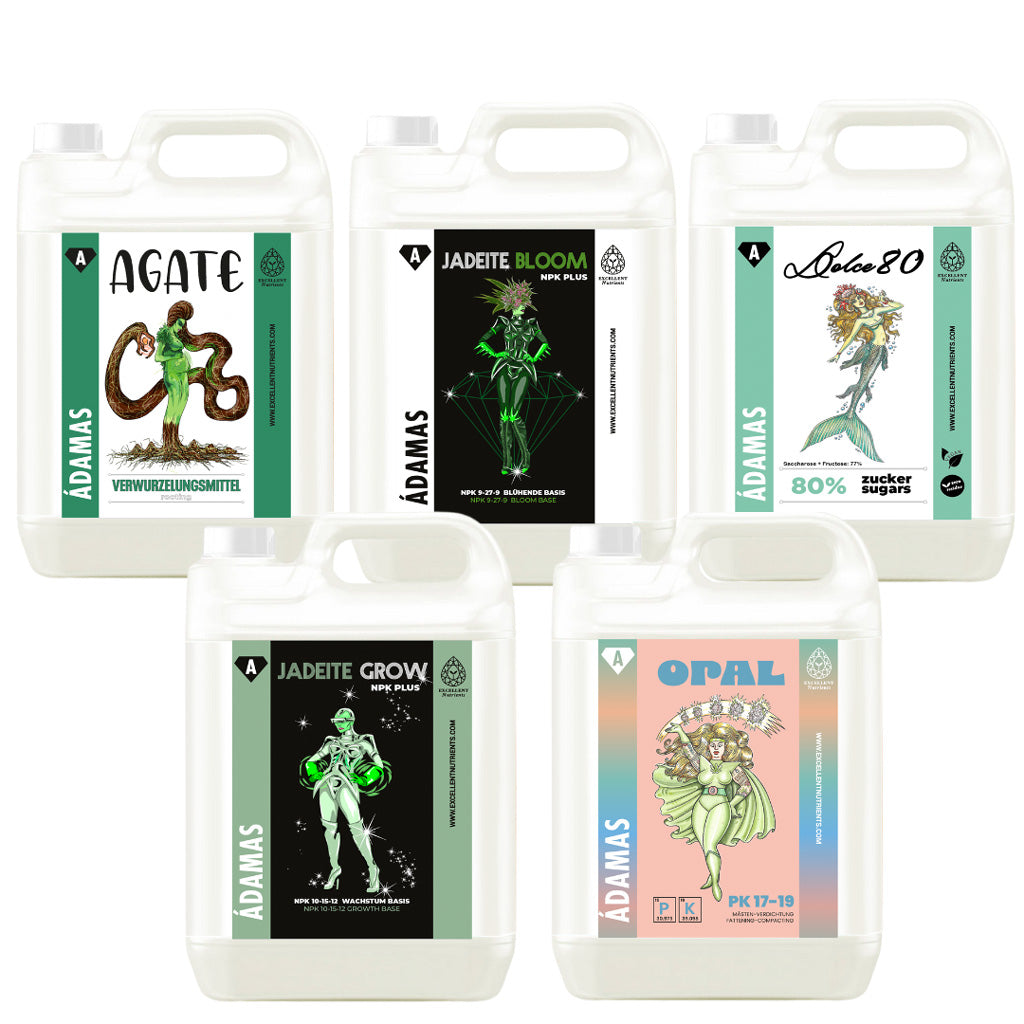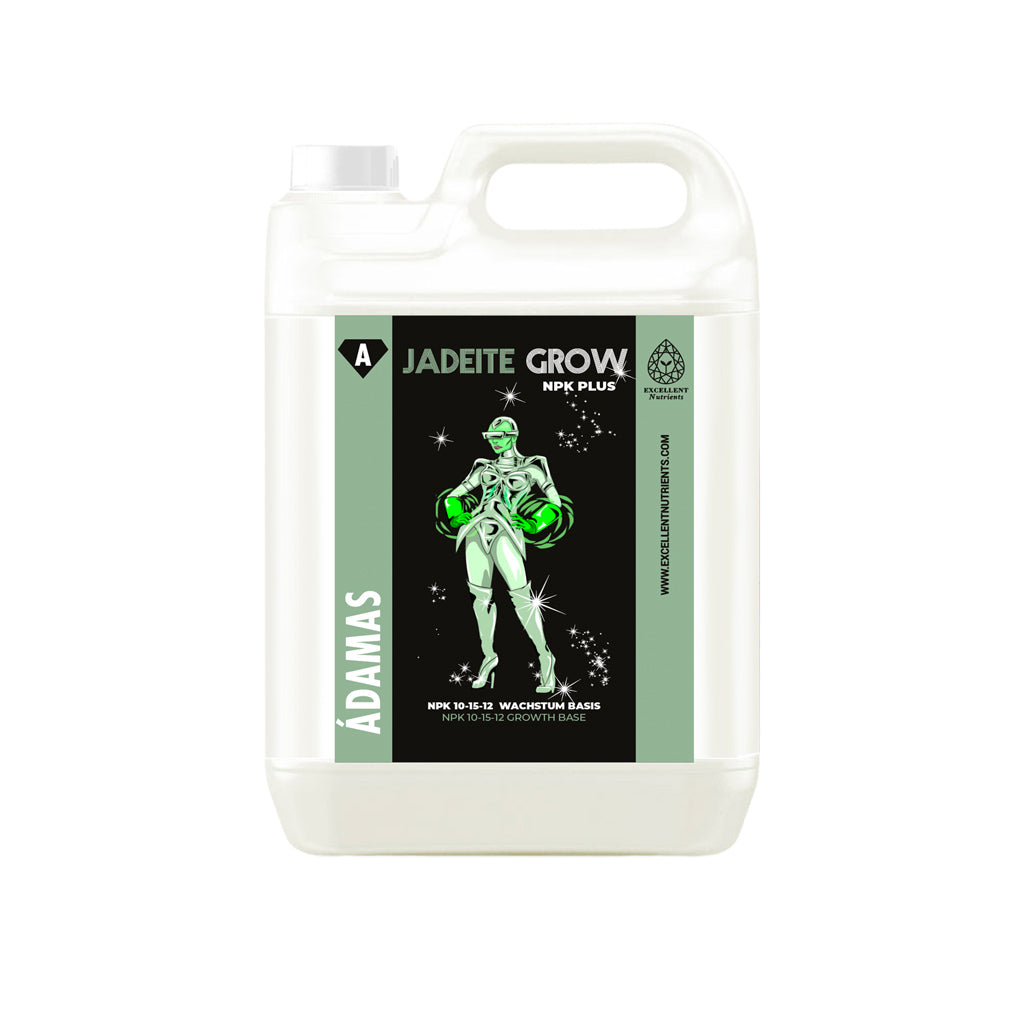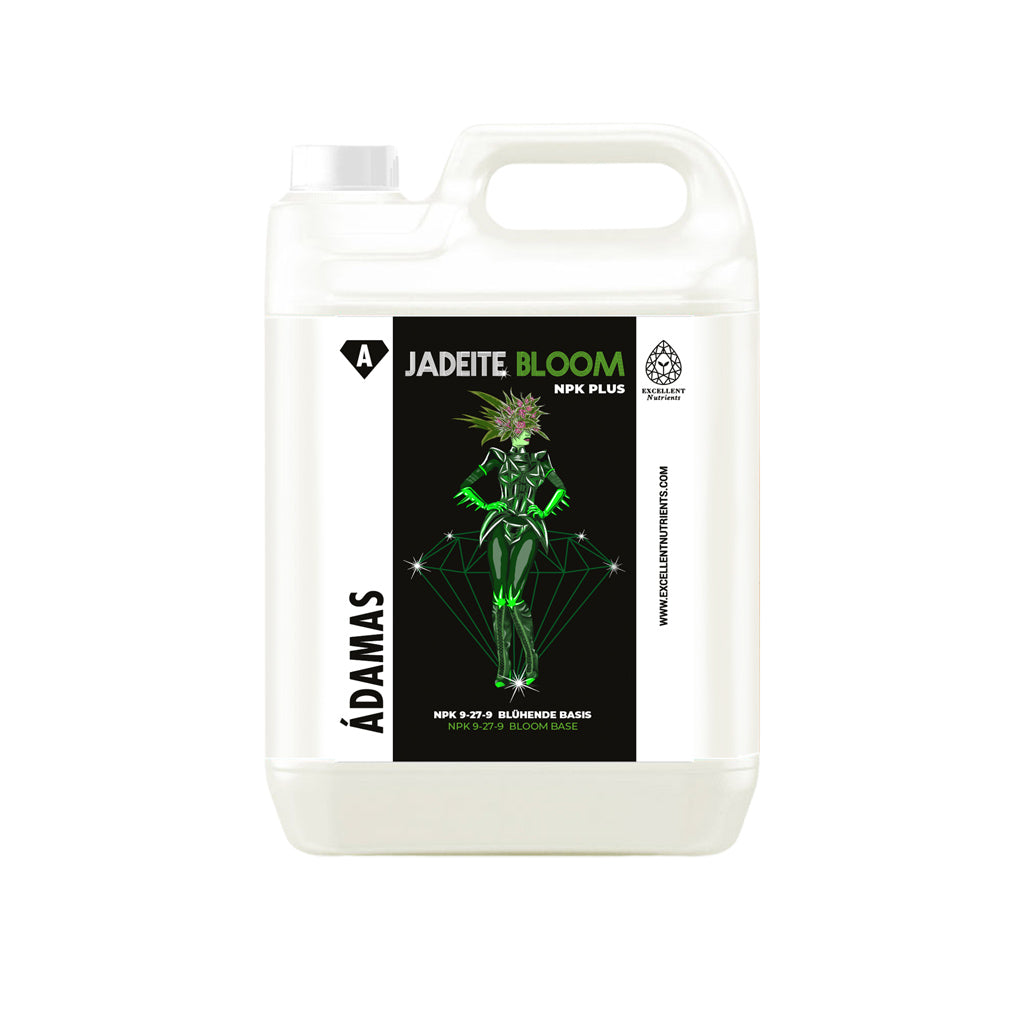How to grow weed indoor
Don't feel like waiting and want to get started right away? With an indoor grow box set, you can grow your plants anytime – regardless of sun or season.
1. Accessories & Basis
Imagine walking into your own grow room—everything is prepared, perfectly tuned, and your plants thrive regardless of the weather. This is exactly what a professional indoor grow box allows you to do. With a complete set, you no longer have to worry about technology, lighting, or ventilation—you get everything from a single source.
The following utensils should not be missing for your indoor grow:
- Indoor grow tent
- LED grow light
- (Activated) carbon filter
- Exhaust fan
- Indoor fan
- Hygro-Thermometer
- Time switch module
- Nutrients
- Three pots
- 20 liters of soil
Three tips for starting indoor cultivation:
A grow tent with sides measuring 60 to 80 cm is ideal for three plants. Make sure each has enough space – and that the light is distributed across the entire area, not just in a specific spot.
Growing cannabis in your home? No problem – with the right grow box for the right climate and light, it's always possible.
Don't worry—if you use a grow tent with a filter and fan, the typical cannabis smell will stay in the tent. Your apartment won't smell of it.
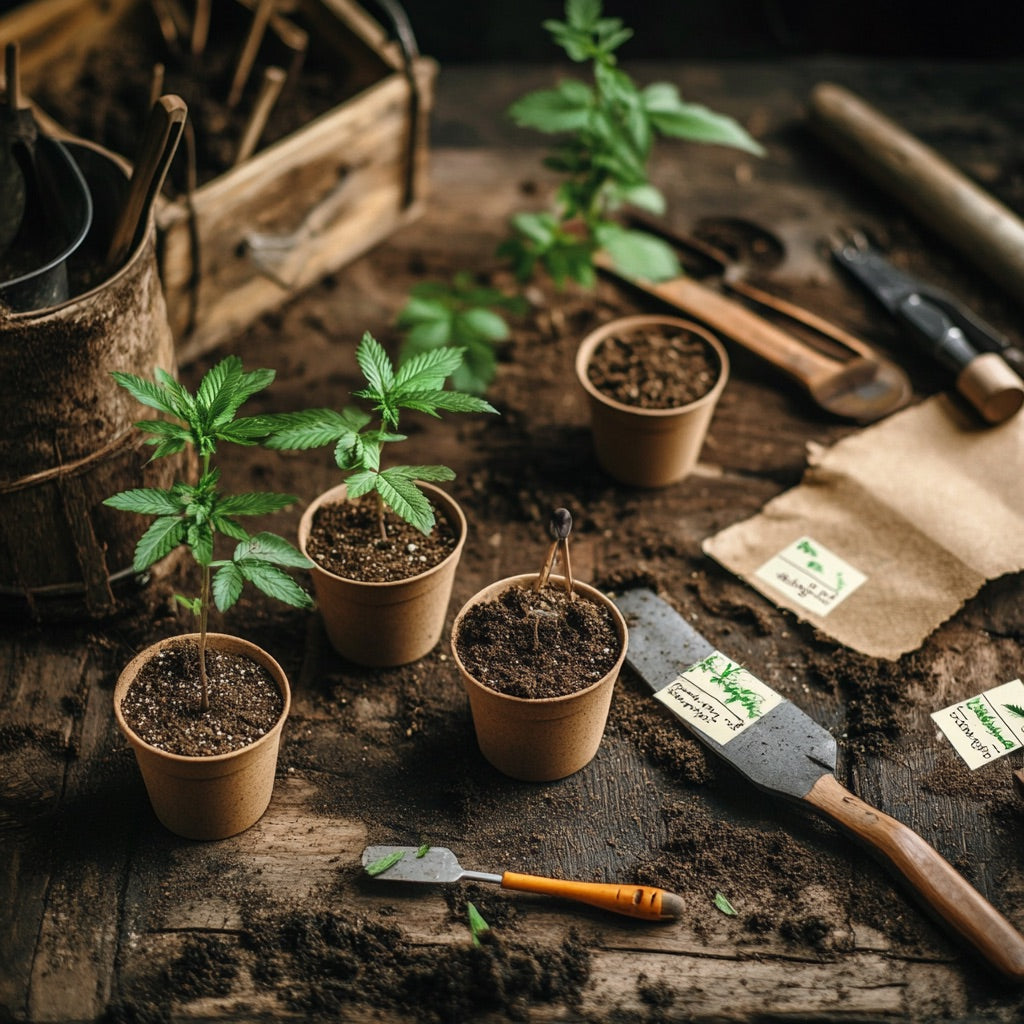
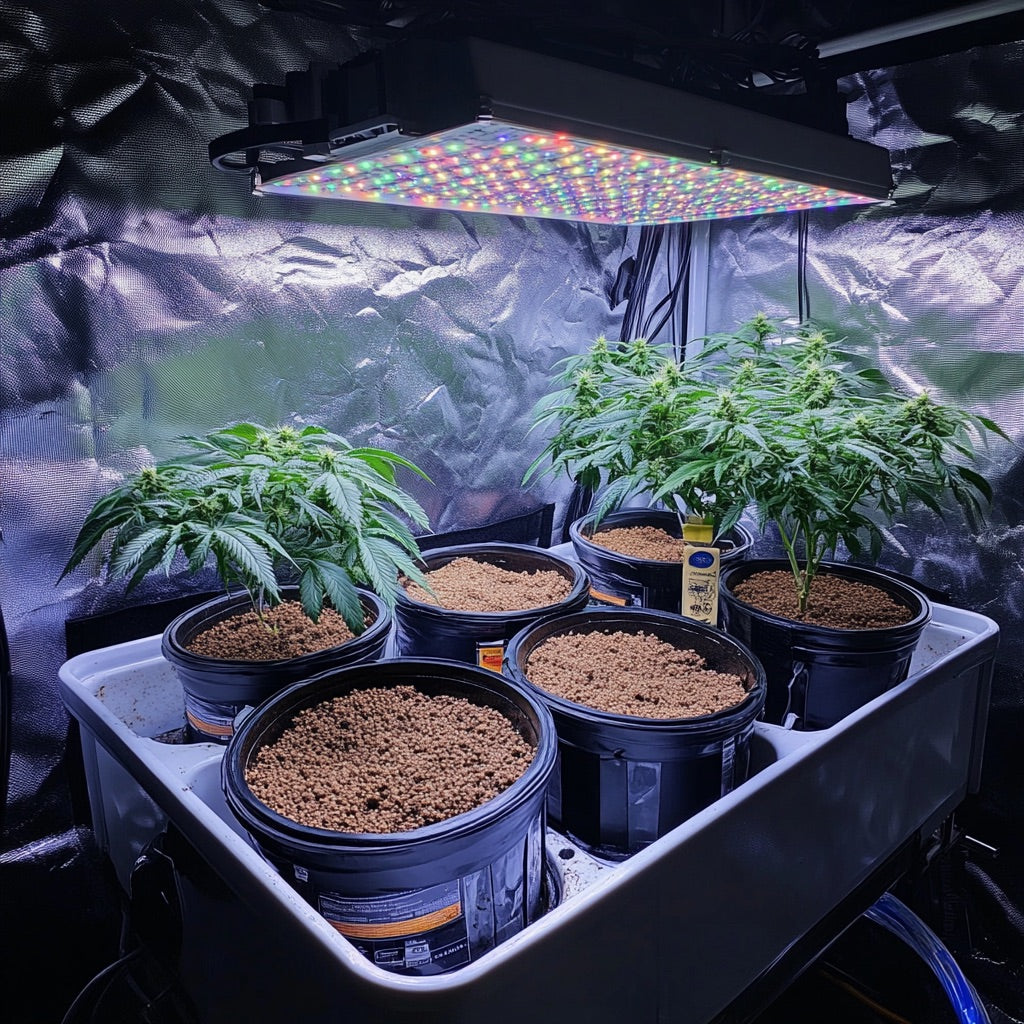
2. Setup
You don't need to be a tech expert—assembling our grow box kits is simple. Two boxes, a little time, and you've got your green oasis.
You will receive two boxes:
• One with tent material and poles
• One with lamp and accessories
a) First the tent:
Lay out the tarp, join the poles according to the instructions, and push them into the tent. Zip the tent halfway to provide stability.
This way the basic framework is secure and you can easily continue with the interior work.
b) Then the lamp:
Hook, carabiner, top bar – done. You can adjust the height later as needed.
It is important that the lamp hangs centrally so that the light falls evenly on all plants.
c) Fan & Filter:
Hang the filter at the top, connect it with a sleeve, mount the fan and position it so that the air flows out.
Make sure that all connections are tight – this ensures effective odor filtration.
d) Finally, the technology:
Clip in the fan, route the cable outside, plug everything in. Set the timer to automatic – and you're ready.
Now all you need is soil, fertilizer and your plants – cultivation can begin.
Three tips for a smooth start:
- Install the exhaust air system before setting up the tent: This makes it easier to align the filters and fans.
- Plan for the height of the lamp: Depending on the lamp, you should leave a distance of 30–60 cm between it and the tips of the plants.
- Check the air flow: Make sure that the exhaust air is directed outside and not back into the tent.
The perfect seeds for your indoor cultivation
View all3. Planting
With an all-round indoor grow kit, you'll receive all the basic equipment you need to start growing plants right away. Follow the three steps, and you'll be able to leave the planting process behind you without any problems.
a) Prepare substrate & cuttings:
Fill the pots with the pre-fertilized soil. Create a hollow in the center that corresponds to the size of the rockwool cube. Insert the cutting, ensuring it is vertical and completely cover the top with substrate to prevent evaporation.
b) Start water supply:
Water each pot with about 0.5 liters of lukewarm water—ideally pH-neutral. Fertilizer isn't necessary for the first two weeks, as the soil contains sufficient nutrients.
c) Position the light source:
Place the pots in the center of the grow tent and position the LEDs about 40 cm from the top of the plants. Even light distribution is essential for a stable start.
Three simple tricks that often make the difference:
- Fingers instead of tools:
The best way to make a small hole for the cutting is with your finger – quickly, accurately and sensitively. - Waiting with the fertilizer:
Let the roots settle in first – in pre-fertilized soil, additional nutrients are only necessary after 2 weeks. - Don’t forget your name tag:
It sounds simple, but it helps – label your pots if you are working with multiple varieties – you will thank yourself later!
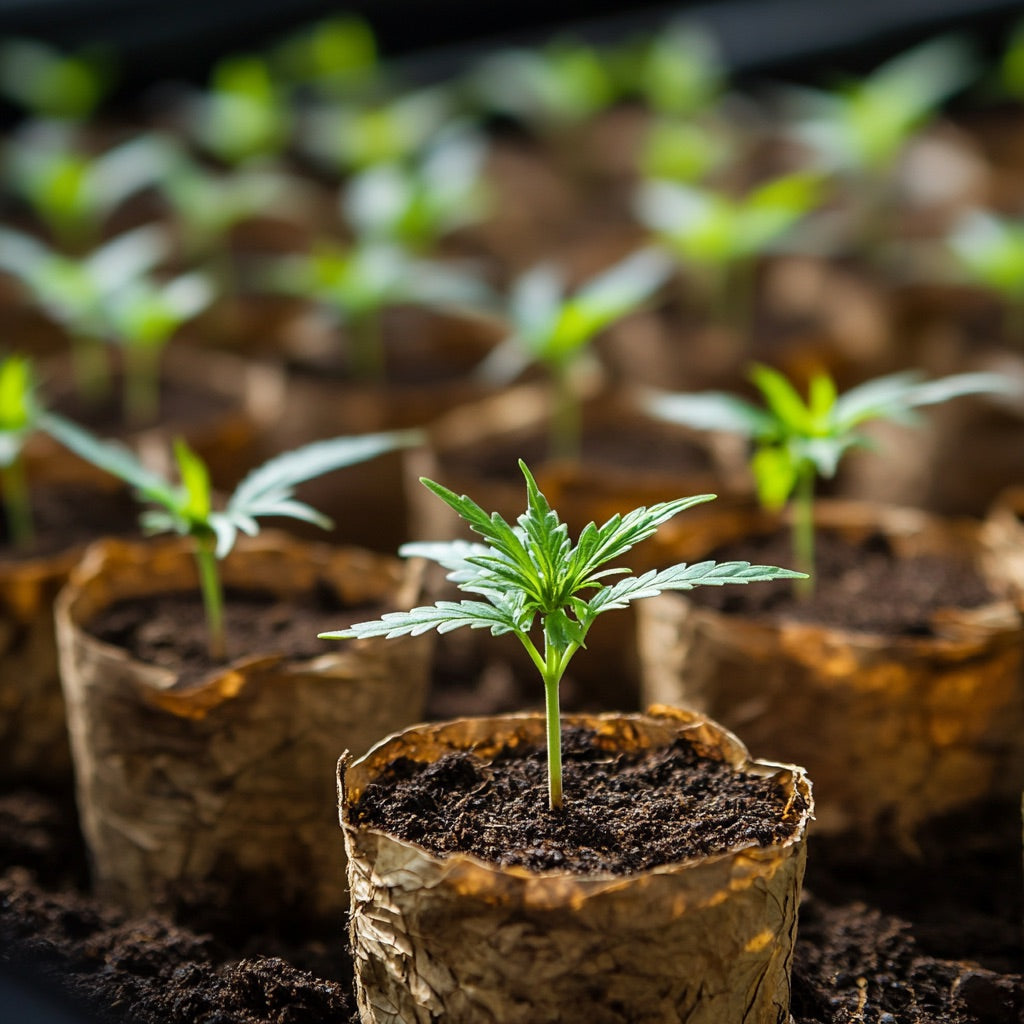
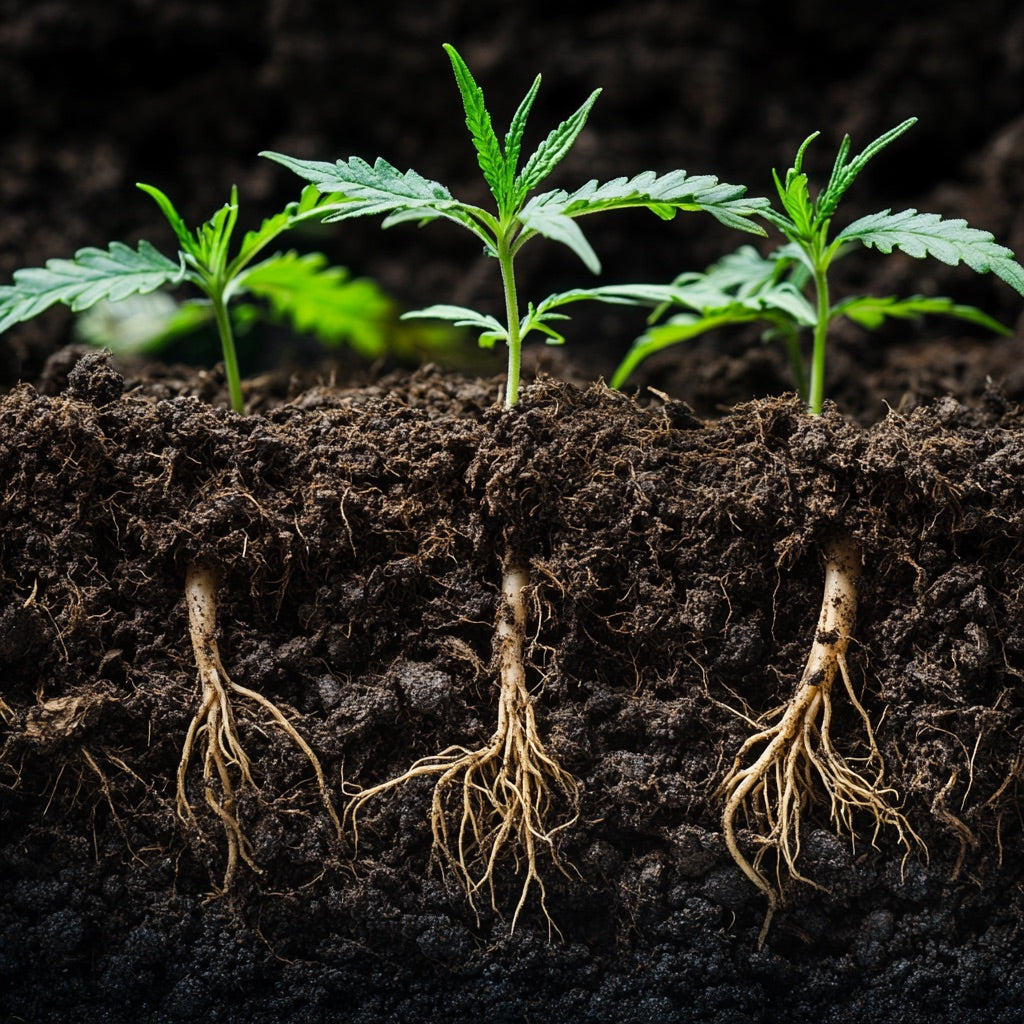
4. Growth phase
In the first two weeks after planting, the quiet but crucial part of growth begins: the vegetative phase. This is when the plant regenerates, stretches upwards, and builds strength. You are now laying the foundation for successful flowering.
What your plant needs now:
a) Light & Rhythm: 18 hours of light daily gives the signal: “Growth is allowed!”
b) Gentle watering: Half to a full liter per pot—not too much, not too little. Pay attention to the soil moisture.
c) Comfortable climate: Temperatures of 20–25 °C during the day, not below 18 °C at night.
d) Humidity: A humidity between 50 and 70% creates the ideal environment.
Three expert tips for better growth:
- It’s better to hang the lamp a little higher at first. Too much light on young plants can lead to light stress – even if it sounds paradoxical.
- The soil is allowed to dry out occasionally—this stimulates root growth. Conversely, persistently wet soil can lead to root rot.
- Avoid stagnant air in your tent. A gentle, constant airflow ensures healthy plant respiration and effectively prevents spider mites and other pest.
5. Flowering phase
Two weeks after planting, you can send photoperiod cannabis plants into the flowering phase—provided they are healthy and sufficiently developed. To do this, set the timer to a 12/12 light cycle. This signals the plant that the days are getting shorter—a natural stimulus for flowering. Depending on the strain, the flowering phase lasts approximately 7 to 10 weeks.
Now she needs energy:
From now on, add 1–2 ml of bloom fertilizer to 1.5 L of water every time you water. In the beginning, it's sufficient to water each plant about 0.5 L every three days. If fertilizing is too complicated for you, simply use a good all-in-one fertilizer like the Grow Fertilizer Starter Set. Alternatively, CBDÍA's fertilizer sets will help you with clear plans for each phase.
Before harvest:
About two weeks before harvest, it's time to water! No more fertilizer, so no residue builds up in the final product. You can often tell when the time is right by the small white hairs on the flowers changing color—usually to dark orange, brown, or even purple.
Three tips for maximizing profits:
- When watering, make sure the water is at room temperature. Cold water can inhibit root growth and slow flower development.
- If you have several plants, regularly turn the pots 90 degrees – this way each side receives even light and grows symmetrically.
- Keep the plant leaves dry when watering. Moisture on the leaves can cause burns under strong light.
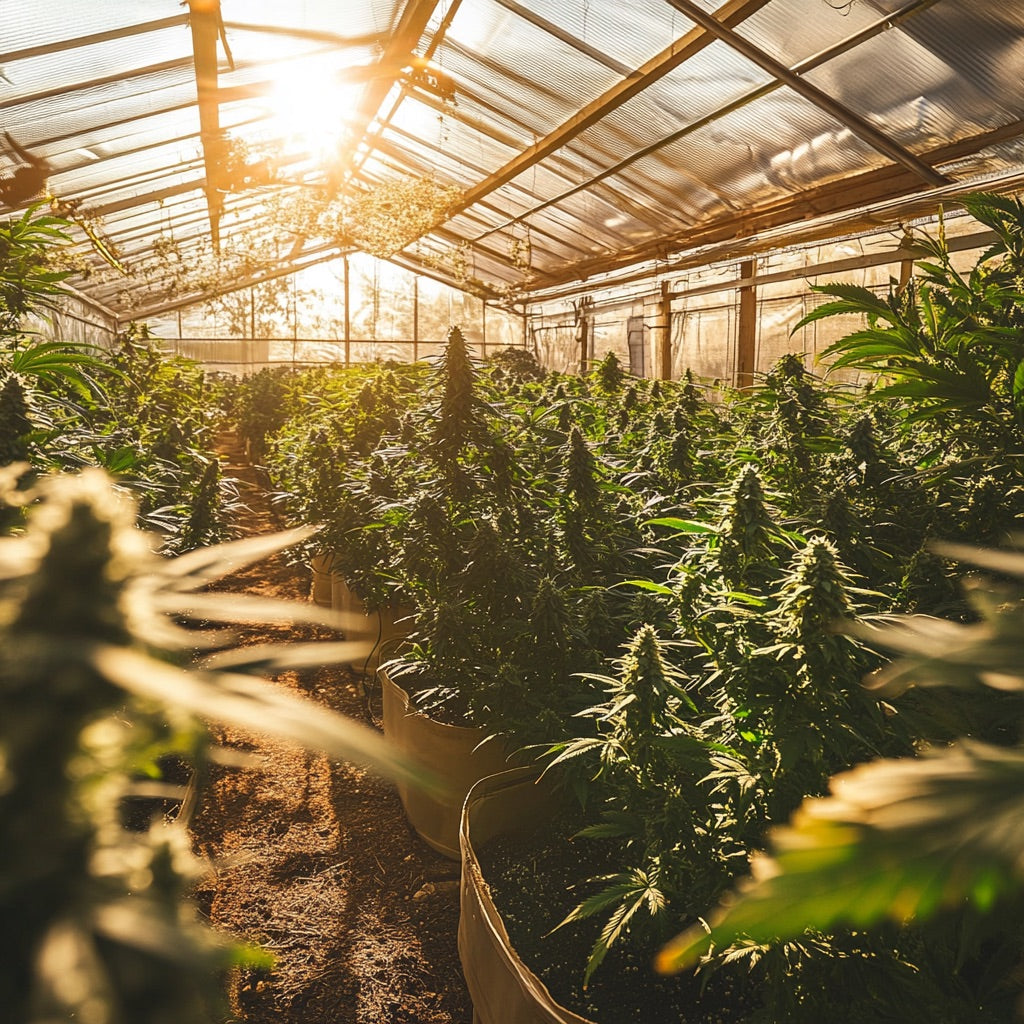
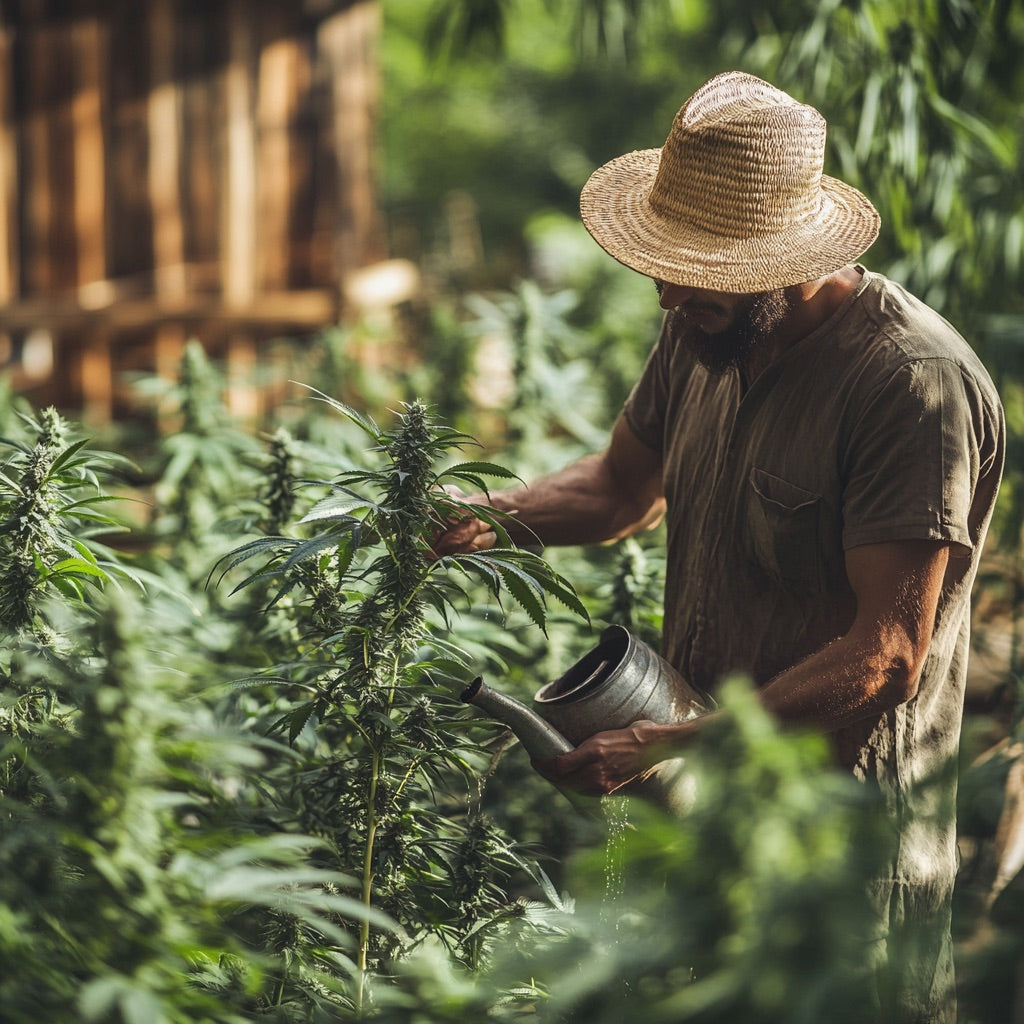
6. Harvesting & Drying
a) Harvesting:
Most growers harvest flowers when about 90% of a plant's pistils turn from pale white to orange/amber/purple (depending on genetics), as this is when THC concentrations should be at their highest. The best way to determine if cannabis plants are ready to harvest is to examine the trichomes under a magnifying glass. Most growers choose to harvest flowers when about 70% of the trichomes have turned milky or cloudy, indicating peak THC production.
b) Drying:
Cut the plant above the ground and hang it upside down in the tent. When drying in the tent, simply remove the lamp and leave the fan in the tent. The fan can run for 24 hours. The humidity should be 50-60% and the temperature between 17°C and room temperature. After about 1-2 weeks, the buds should be dry and firm. Cut the buds from the stems of the plant. Also remove any small leaves and excess stems. Place the cut buds in an airtight jar. For the next 1-2 weeks, gently shake the jar of flowers every day. Leave the jar open for 10-15 minutes to allow the moisture to escape. After about 1-2 weeks, you will have your first cannabis buds and can enjoy them. Enjoy!
How to grow weed outdoor
Want to grow cannabis in your own garden or on your balcony? This outdoor growing guide will teach you everything you need to know—including tips on soil, lighting, and harvesting. Start now with our complete kit for outdoor growers.
1. Organization
The optimal location for outdoor cultivation offers at least 6-8 hours of direct sunlight daily. Balconies, terraces, or wide south-facing windowsills are suitable. The temperature at the location should not fall below 12°C. Additional protection from weather influences such as heavy rain or gusts of wind increases the survival rate of the young plants.
To get started you need:
- 3 growing pots with saucers
- 18–20 L of nutrient-rich soil
- 3 cuttings or seeds
If you're using seeds instead of cuttings, here's how to germinate them: Place the seeds between two damp paper towels and place them in a closed container in a warm, dark place. After 2–4 days, the first radicles should appear.
Three tips for the best start:
- Correct timing: It is best to pre-germinate seeds at the beginning of April so that the young plants can be planted outdoors from mid-May.
- Masking the smell: Add strongly scented plants such as lavender or lemon balm as natural odor camouflage.
- Targeted site selection : Choose a location with 6-8 hours of direct sun per day, protected from wind and heavy rain.
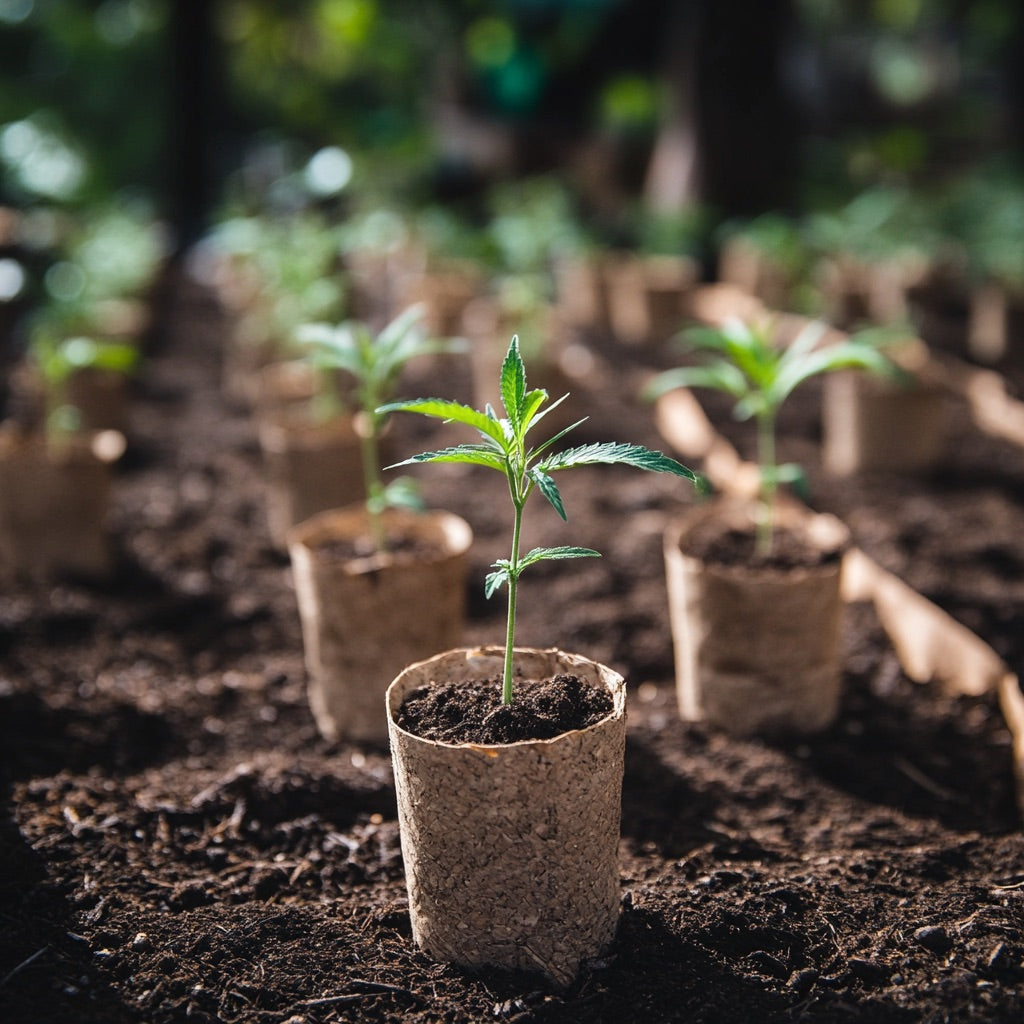
Organic yield maximization for your cannabis cultivation
View all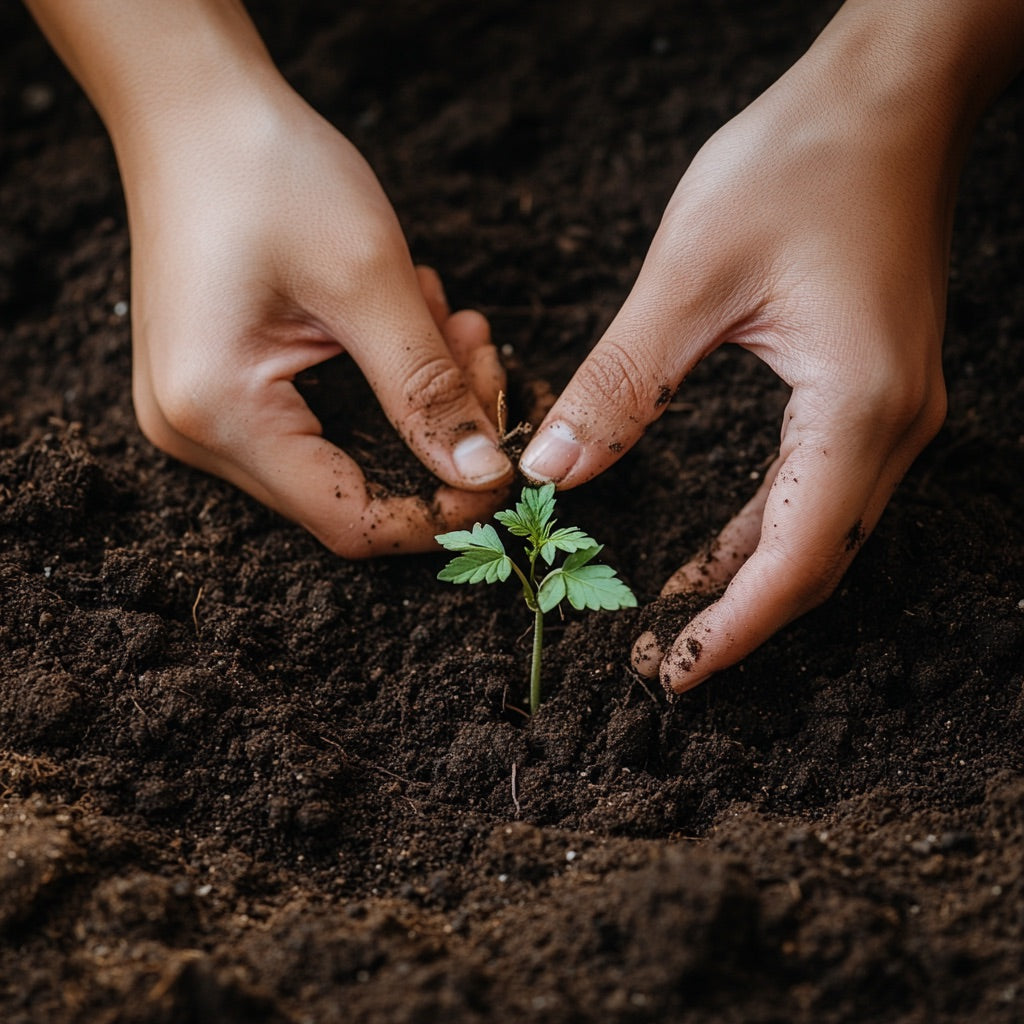
2. Planting
a) Preparation:
Place three pots on the saucers and open the bag of pre-fertilized soil.
b) Filling:
Fill each pot evenly with soil and form a small hollow in the middle – just big enough to fit the cutting and the growing cube.
c) Insert:
Carefully insert the cutting and cover the cube with a thin layer of soil until it is no longer visible.
d) Casting:
Divide 1.5 liters of lukewarm water among the three pots – about 0.5 liters per plant. No additional fertilizer is necessary for the first two weeks.
e) Place:
Place the pots in a sunny, sheltered location outdoors – ideally at least six hours of sunlight per day.
Three tips for the best possible planting:
- Your pots should have drainage holes to prevent waterlogging.
- Insert the cuttings only deep enough so that the cube is just covered with soil – do not press down more firmly than necessary.
- Water lightly right after planting so the soil settles well around the roots.
3. Growth phase
The vegetative phase describes the period from germination to the beginning of flowering. When grown outdoors, this phase is determined by the natural progression of daylight hours. If the plants are placed outdoors from mid- to late May, they will continue to develop until the end of July before flowering due to shorter days.
During this time the following applies:
a) Watering: About every three days, about 1.5 liters of water are distributed among the three pots – depending on the weather and temperature.
b) Fertilizing: From the third week onwards, 1-2 ml of growth fertilizer can be added to the irrigation water to support plant growth.
With these three tricks you can achieve the healthiest growth:
- During hot summer days, it is better to water in the morning and/or evening – this way less water evaporates and the plants are less stressed.
- A nearby herb bed can help: plants such as basil, mint or lemon balm have a deterrent effect on many pests.
- During dry periods, the top layer of soil is allowed to dry out – this stimulates root formation and strengthens the plant in the long term.
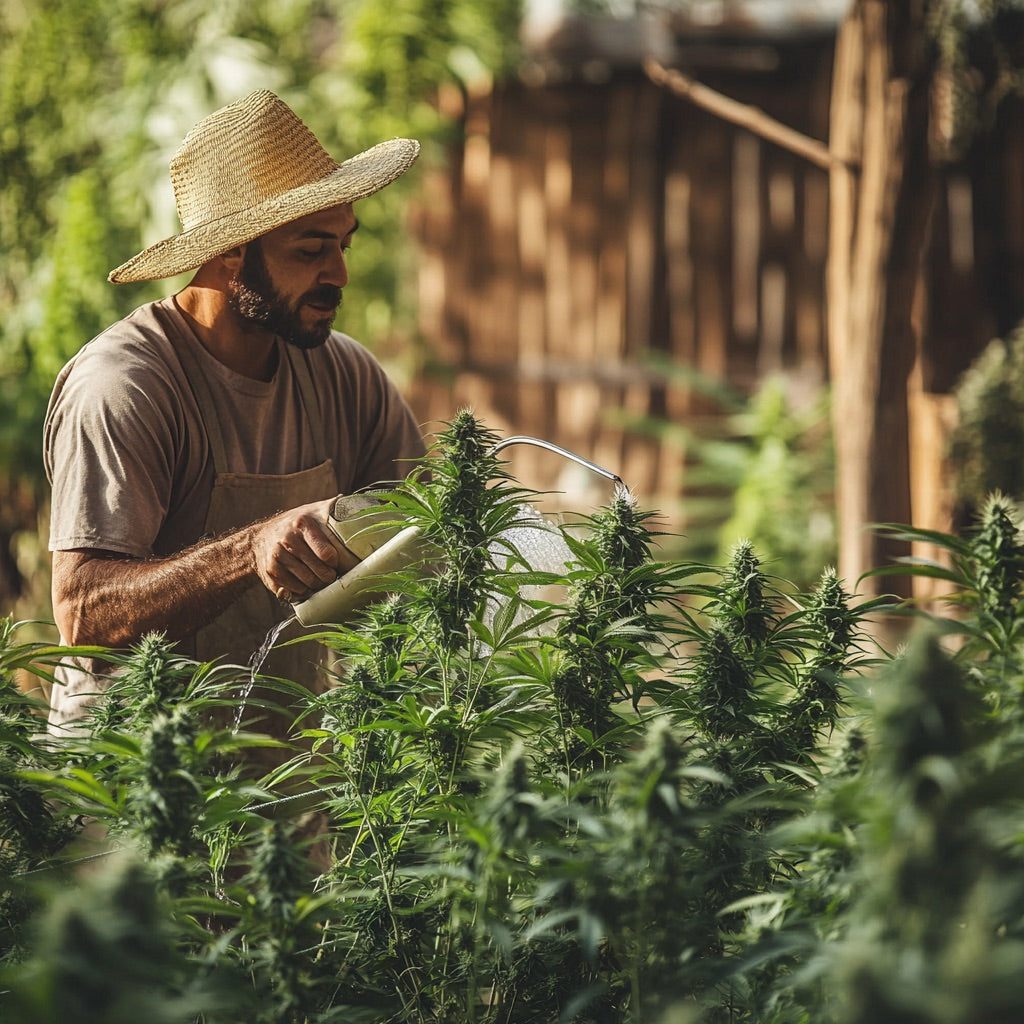
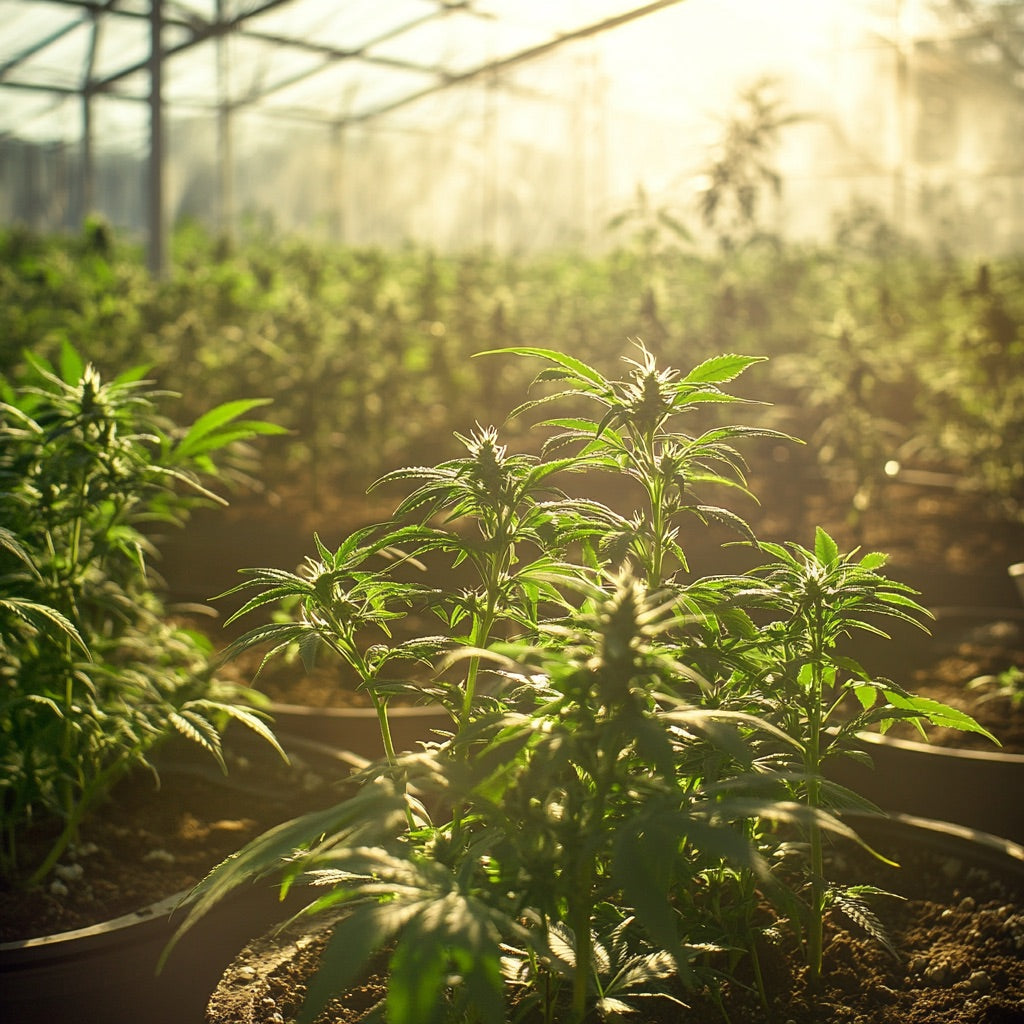
4. Flowering phase
When the first flower hairs appear, the most important phase begins: flowering. This usually starts around the end of July and lasts about two months, depending on the strain. The plant changes significantly at this point – it becomes bushier and focuses entirely on the formation of its cannabis flowers.
During this time, it is important to have a consistent supply of water, sufficient light and a protected place.
Two weeks before harvest, reduce care to the bare essentials: pure water, peace and quiet, and a little patience – so that the plant can prepare for its natural finale.
Three tips for maximizing profits:
- The more direct sun your plant receives, the more compact and resinous the flowers will be. South-facing locations with at least 6–8 hours of sunlight per day are ideal.
- Plants that are slightly elevated (e.g. on a wall or table) receive more heat and light, which accelerates ripening.
- If the humidity is high, you can use a handheld fan to circulate the air in the morning on days when it is particularly at risk.
5. Harvesting & Drying
a) Harvesting begins when:
- Around 90% of the pistils are colored
- The trichomes appear milky – visible with a magnifying glass
b) The drying process:
- Cut the plant completely and hang it upside down in a dark, quiet room
- Buds hang freely, without contact with walls
- Climate: 50–60% humidity, 17–22 °C
c) After 1–2 weeks:
- Flowers firm & dry → Now it's time to graft
- Remove stems and leaves and place flowers in sealable jars
- For 10–14 days daily: Open jars for 10–15 minutes, shaking gently to allow air circulation
d) Three tips for the highest quality:
- Ideally, harvest in the morning when resin production is still active and the plant is not stressed.
- The drying room should be dark and well-ventilated – light can break down cannabinoids.
- Longer curing (3–6 weeks) often produces even more aroma and a rounder taste – especially with aromatic varieties.

FAQs about growing cannabis
Indoor Grow
Indoor growing is also easy for beginners – especially with modern complete sets that already contain coordinated technology. The most important basics, such as light control, watering and temperature, are easy to learn. If you take it step by step and use high-quality products, you can achieve good results right from the start.
The most common beginner mistakes include:
- Incorrect distance between plant and lamp
- Overwatering or under-watering
- Excessive humidity during the flowering phase (→ risk of mould)
- Lack of air circulation
- Incorrect light cycle (e.g. continuous light during flowering)
These mistakes can be easily avoided with good instructions and a little attention.
For a grow box measuring 60×60 cm or 80×80 cm, the monthly operating costs (electricity, fertiliser, water) are between €10 and €20. LED technology saves electricity without compromising on yield. In addition, there are expenses for cuttings, soil and occasional consumables.
Yes, a quick daily check is necessary – especially during the growth and flowering phases. A quick glance at the light, temperature, humidity and condition of the plants is sufficient. This allows you to react early to problems such as pest infestation, drought or excessive growth.
A complete indoor growing cycle takes around 10–14 weeks, depending on the genetics:
- 1–2 weeks germination and cultivation
- approx. 3–5 weeks growth (vegetative phase)
- 7–10 weeks flowering phase
Automatic varieties can mature slightly faster, while photoperiodic varieties usually offer higher yields.
Outdoor Grow
A certain amount of weather influence is part of outdoor cultivation – and can even be beneficial: Regular wind provides movement and strengthens the plant, leading to stronger stems and better root anchorage.
However, in the event of strong winds, heavy rain, or severe weather, protection is recommended—e.g., with wind barriers, portable roofing, or relocation to a more sheltered location. Excessive moisture on the flowers can cause mold during the flowering phase.
Starting around the third week after planting in the pot or garden bed, you can begin gently adding nutrients—by then, the pre-fertilization of the soil will usually be used up. A nitrogen-rich fertilizer is suitable during the growth phase.
As soon as the plant enters the flowering phase (from the end of July), switch to a phosphorus- and potassium-rich bloom fertilizer. The frequency depends on the product and weather conditions—if the soil is unstable, fertilize regularly but sparingly.
After heavy rainfall, the soil is often so moist that nutrients can leach out – especially in potted plants. Fertilizing is a good idea in this case, but not immediately: Wait until the soil has dried out slightly before re-fertilizing.
If it has only rained lightly and you would have watered anyway, you can safely add fertilizer to the watering water – the main thing is that the soil is not completely saturated.
Outdoors, natural wind usually ensures sufficient air movement – this stimulates the plant structure and at the same time prevents mold and fungi.
It's important that your plants are placed in a well-ventilated area, not too close together. If air can circulate between the shoots, additional ventilation isn't necessary. However, in periods of persistent calm or high humidity, it may be helpful to provide some targeted leaf pruning or occasional airflow (e.g., with a fan in a greenhouse).
Both genetics have their advantages – it depends on your goals and conditions.
a) Automatic varieties (autoflower):
- Ideal for beginners
- Not time-dependent – they flower automatically after approx. 3–5 weeks
- Less susceptible to mould, as they remain smaller and are ready for harvest sooner
- Perfect for short summers or two harvests per season
b) Photoperiodic varieties:
- Higher yield potential and more intense aroma
- Use natural light control (usually flowering from the end of July)
- Require a longer growing period and stable conditions
- Ideal if you have a sunny, sheltered spot and time until October
Conclusion: If you want full control and space, choose photoperiodic varieties. For fast, robust results with easy care, automatic varieties are the better choice.
Johannes Max Harms
As one of the pioneers of the German cannabis scene, Johannes Max Harms has developed over the years into one of the most sought-after cannabis experts in the German-speaking world. Driven by his passion for cannabinoids, he has specialized in the formation of terpenes in the cultivation of photoperiod cannabis plants. Thanks to his in-depth knowledge in the field of sensory and microbiological testing, he has been part of an independent sensory panel for several years.














